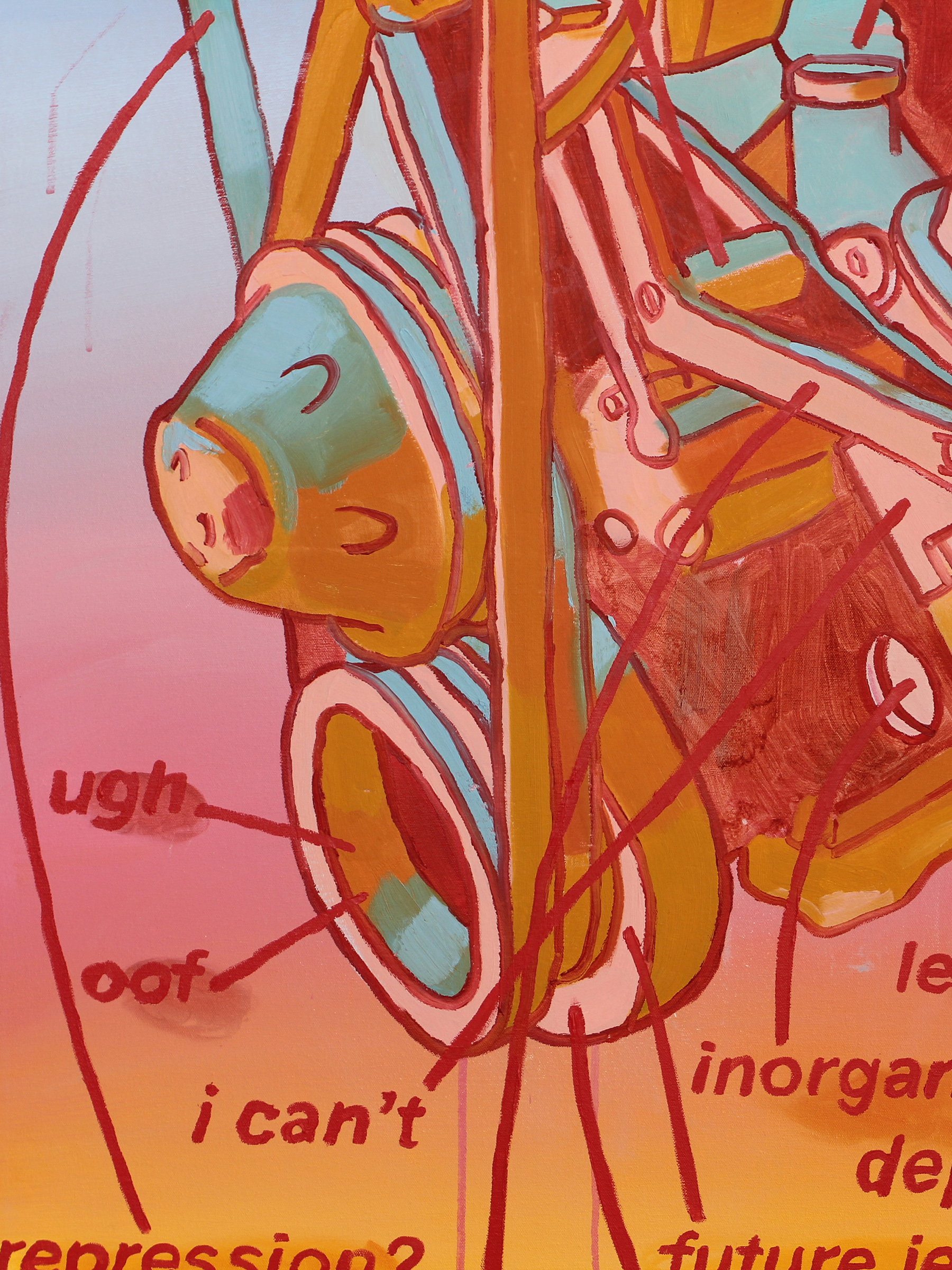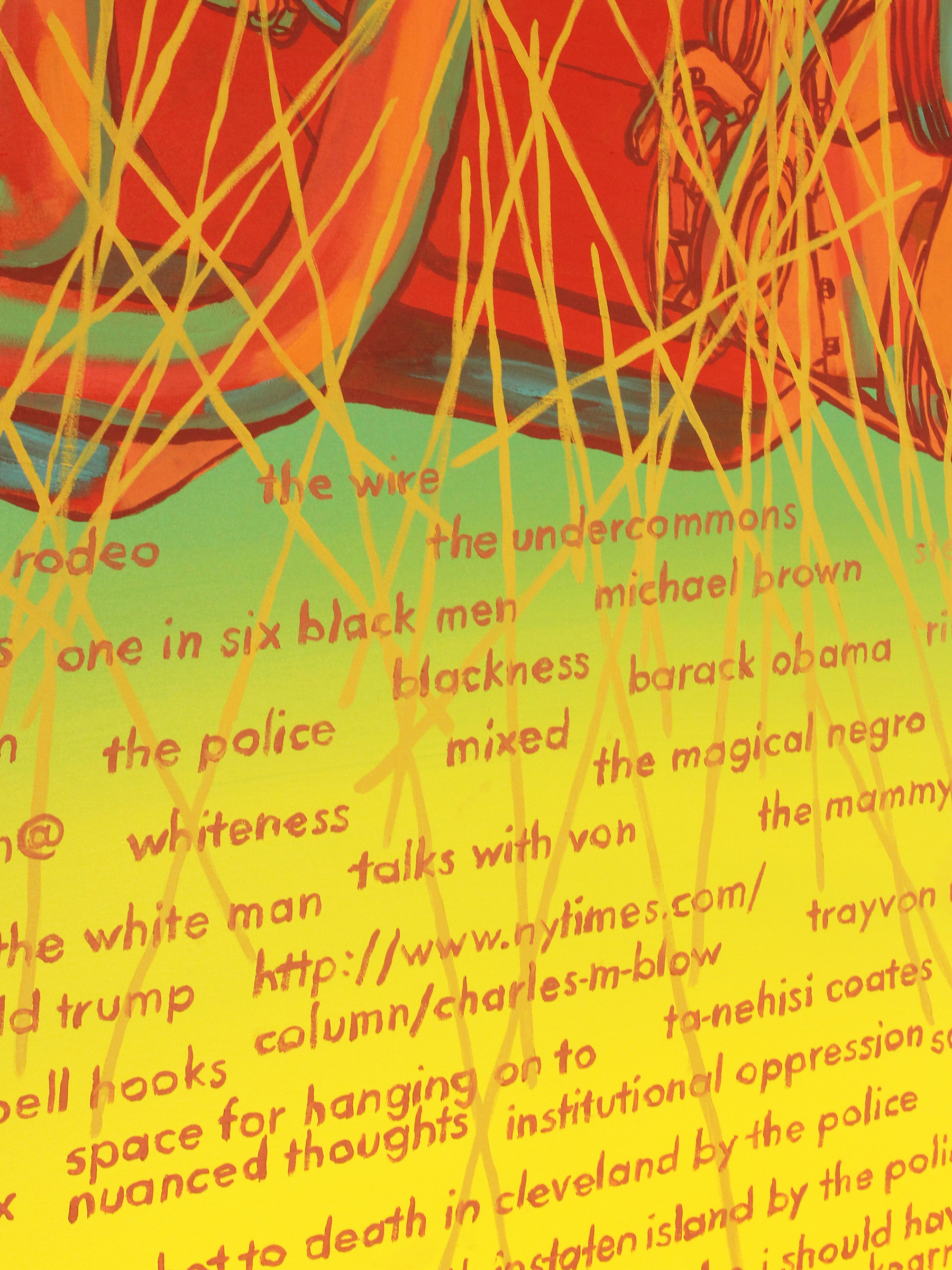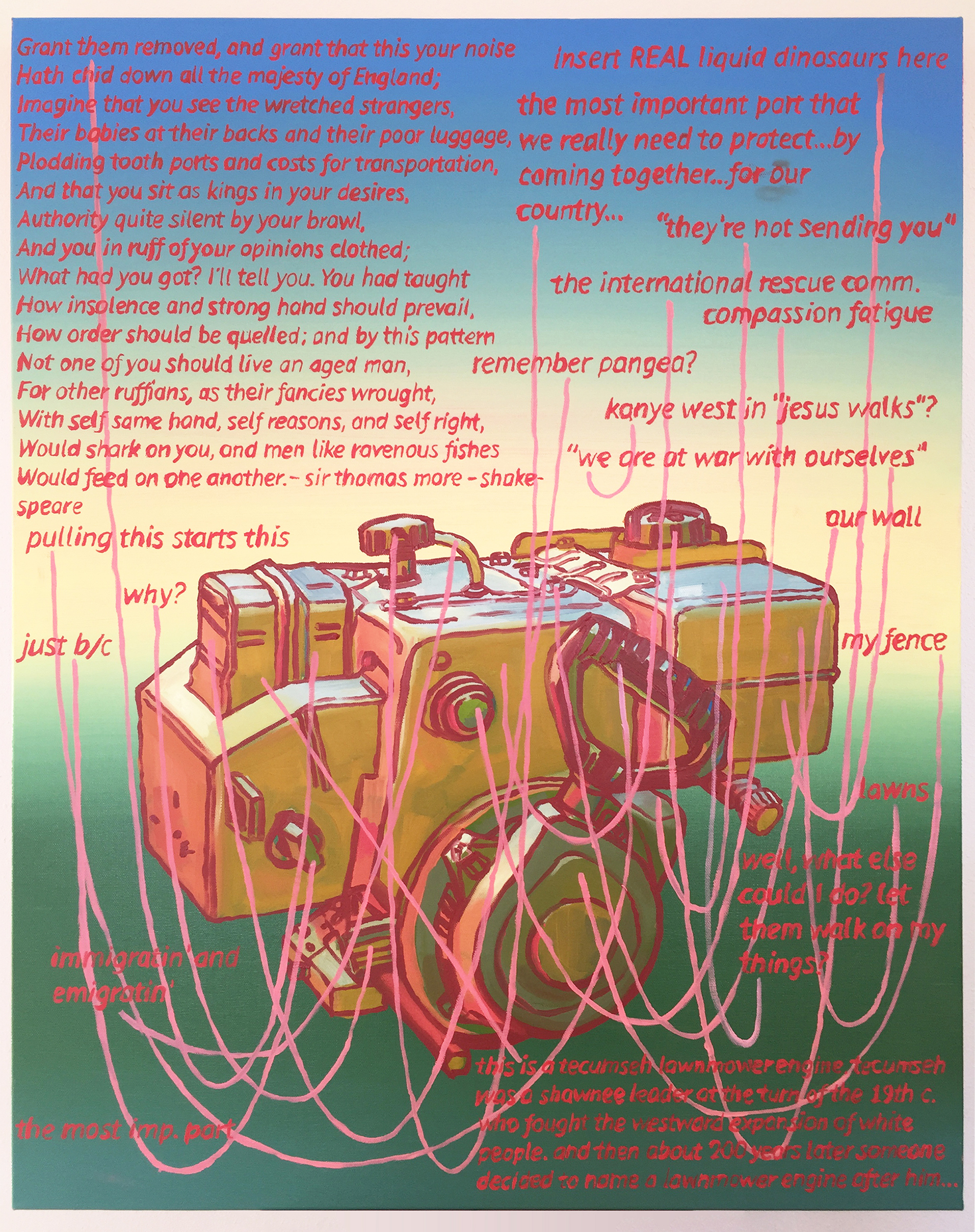Engine Studies
exhibited at Live in Jacksonville
2015
MOCA Jacksonville , Jacksonville, FL
In the Engine Studies paintings, diagrams of mechanical engines reveal nothing useful about how those engines function. Instead of labeling the components, the text in these paintings relates to me. In the first group, which were featured in an exhibition at MOCA Jacksonville, one painting is about race, one is about the internet and the third is about some things I happened to be thinking, feeling, and doing when I made the painting. At the time, I had been thinking about my position within various systems. Then I thought about engines and their role in human mobility, community, ingenuity, and atrocity. In these paintings, I wanted a space to pose questions and spit out ideas. The combined imagery and text of the diagram, a common pedagogical tool, helped me unify and legitimize disparate words and phrases. Alongside each painting in the Jacksonville show was a laser-engraved plaque with YouTube-style comments about the painting.
2015
MOCA Jacksonville , Jacksonville, FL
In the Engine Studies paintings, diagrams of mechanical engines reveal nothing useful about how those engines function. Instead of labeling the components, the text in these paintings relates to me. In the first group, which were featured in an exhibition at MOCA Jacksonville, one painting is about race, one is about the internet and the third is about some things I happened to be thinking, feeling, and doing when I made the painting. At the time, I had been thinking about my position within various systems. Then I thought about engines and their role in human mobility, community, ingenuity, and atrocity. In these paintings, I wanted a space to pose questions and spit out ideas. The combined imagery and text of the diagram, a common pedagogical tool, helped me unify and legitimize disparate words and phrases. Alongside each painting in the Jacksonville show was a laser-engraved plaque with YouTube-style comments about the painting.
credits
Jim Draper - curator
Susan McClung Barrow - housing and support
Susan McClung Barrow - housing and support

[This acrylic and oil painting from 2015 is called Engine Study I. It is 4 feet wide and 5 feet tall. The painting resembles a standard diagrammatic image with lines extending from the engine parts to identifying italicized text. However, the text is not relevant to the engine. Instead, it presents a selection of words and phrases that were relevant to Avery at the time of painting. From left to right, top to bottom they read: constituent part, productive opacity, protective opacity, emotional boundary, physical boundary, self-loathy timer, phew, pain, nope, super special filter, anxiety, terry gross, a little shame, spinny part, escitalopram, mout hole, poop, fear, marc maron, ugh, off, leaky space, i can’t, inorganic material, exhaust(ed), repression?, depressive, future jelly rollz, disembodied voices, trial and error, a little more shame (with shame crossed out), and the penis part. Instead of text, one line terminates with a Bluetooth symbol and another with a straight-mouthed face emoji. The engine is painted with oranges, blues, pinks, and reds. A dark red contour line defines the edges and interior details of the engine. A slightly lighter red is used for the diagrammatic lines and identifying text. A top-to-bottom, blue-red-yellow gradient fills the background.]

[Some of the details in Engine Study I. We see the belts, cams, covers, and gaskets on the left side of the engine. This close-up image reveals the varied quality of the brushstrokes and thickness of the paint. The red lines and italicized text, for example, are less tidy in this zoomed-in image. The lines occasionally blob or wisp, demonstrating a heavy hand or a hurried end stroke. Under some of the text are visible circular smudges of paint, indicating incomplete removal of red paint. Two red drips stain the top-left portion of this portion of the painting. With regards to the application of paint, in some areas raised, shiny brushstrokes indicate thickness and, in other areas, translucency reveals underpainting and thinness. The words fully visible in this detail are ugh, oof, i can’t.]

[The award-style plaque for Engine Study I next to a portion of the painting. Each Engine Study painting has its own laser-etched metal plaque, which is mounted on dark wood with a beveled edge. Each plaque contains internet-style comments from fictional characters about the adjacent painting, as well as the like/dislike metrics concerning each comment, indicated with a thumbs-up or thumbs-down symbol and a number. This plaque reads “SuzeeQ: This guy is amazing! Haploid Friend: yeah totally. George_Dad: what is this crap? modern art sux. this artist sux. Easy Pea: The thing that is so trippy about Avery Lawrenve is when adds something to the painting it always looks like a mistake or oversimplified. Then he adds a few simple details or adds another ‘mistake’ beside it and suddenly what looked a child slapping paint on a canvas haphazardly, suddenly looks very good. And then he repeats the process until he has a finished painting. Wanda: Easy Pea u r way 2 into this dude. r u gay or something? MIKE: Why does someone passionate about the artistic process have to be gay, Wanda? You probably wouldn’t know moma from a chucky cheese. Sharon_1: MIKE, it’s Chuck E Cheese’s. Jerrod H: what’s escitalopram? FancyNancy38: https://en.wikipedia.org/wiki/Escitalopram. Jerrod H: thanks, FancyNancy38.”]

[This acrylic and oil painting from 2015 is called Engine Study II. It measures 4 feet wide and 5 feet tall. Like the first painting in the Engine Study series, this second painting resembles a standard diagrammatic image with lines extending from the engine parts to identifying italicized text. Like the first painting, the text has nothing to do with the engine. Instead, the words reflect a sampling of Avery’s associations with race in the United States at the time of painting. From left to right, top to bottom the text reads: key and peele, black study, sally hemings, the wire, angola prison rodeo, the undercommons, fred moten, the prisons, our prisons, blazing saddles, one is six black men, michael brown, stefano harney, talks with emily, my mom, the police, blackness, barack obama, richard pryor, slavery, lynchings, latin@, whiteness, mixed, the magical negro, coon smile, garret square soccer team, the white man, talks with von, the mammy, gator bait, charles gaines, donald trump, http://www.nytimes.com/column/charles-m-blow, black face, our american south, bell hooks, trayvon martin, i need to read: autobiography of malcolm x, new jim crow, ain’t i a woman, white privilege, junot diaz, angela davis, james baldwin, and others, many others. fuck. I wish I were a faster reader, space for hanging on to nuanced thoughts, ta-nehisi coates, the n-word, institutional oppression, sandra bland, child who was shot to death in cleveland by the police, adult who was choked to death in staten island by the police, the jerk, space for being wrong, learning, ugh. maybe i should have taken that class with douglas harney, darren wilson, my role/whiteness/privilege, aunt jemima, just wanting to be good/fair/just/loving/open. The engine is painted with oranges, greens, and blues. A burgundy contour line defines the edges and interior details of the engine. Mustard yellow is used for the diagrammatic lines. A Light brown is used for the identifying text. A top-to-bottom, blue-to-yellow gradient fills the background.]

[A close-up photograph of Engine Study II. In this image, taken from a slight angle, the texture and irregularity of the lines is more visible. The lines (of the diagram, the text, and the engine’s contour) fluctuate in thickness and density; in many areas the painting’s background gradient is visible through the mottled lines. This image is mostly yellow: a highlighter yellow background covered with a web of mustard yellow lines. At the top of the painting, the lines cross over the bottom portion of the engine, painted with oranges, greens, blues, and maroons. The light, reddish brown text visible in this image reads: the wire, rodeo, the undercommons, one is six black men, michael brown, the police, blackness, mixes, barack obama, whiteness, the magical negro, the walk man, talks with von, the mammy, trump, http://www.nytimes.com/column/charles-m-blow, trayvon, bell hooks, space for hanging on to nuanced thoughts, ta-nehisi coates, institutional oppression, …to death in cleveland by the police, …staten island by the police.]

[The fourth in the Engine Studies series, this acrylic and oil painting measures about two feet wide and 3 feet high. Engine Study IV was commissioned by James Wood as a gift for Felicity Hannay. In this physically smaller Engine Study painting, a lawnmower engine is depicted in diagrammatic form. As if suspended between the identifying text and various parts of the engine, pink lines dangle, pulled by gravity, creating a collection of nadirs that overlap the engine toward the bottom of the canvas. The engine is mostly olive green with moments of pink, blue, white, and yellow. Burgundy lines define the contours and details of the engine. The text, which samples Avery’s associations with immigration at the time of painting, is red. From left-to-right, top-to-bottom, the text reads: “Grant them removed, and grant that this your noise hath chid down all the majesty of England; imagine that you see the wretched strangers, their babies at their backs and their poor luggage, plodding to the ports and coasts for transportation, and that you sit as kings in your desires, authority quite silenced by your brawl, and you in ruff of your opinions clothed; what had you got? I’ll tell you: you had taught how insolence and strong hand should prevail, how order should be quelled; and by this pattern not one of you should live an aged man, for other ruffians, as their fancies wrought, with self same hand, self reason, and self right, would shark on you, and men like ravenous fishes feed on one another, insert REAL liquid dinosaurs here, the most important part that we really need to protect…by coming together…for our country…, ‘they’re not sending you,’ the international rescue comm., compassion fatigue, remember pangea?, kanye west in ‘jesus walks,’ ‘we are at war with ourselves,’ our wall, pulling this starts this, why?, just b/c, my fence, lawns, well, what else could I do? let them walk on my things?, immigratin’ and emigratin’, the most imp. part, this is a tecumseh lawnmower engine. tecumseh was a shawnee leader at the turn of the 19th c. who fought the westward expansion of white people, and then about 200 years later someone decided to name a lawnmower after him….” ]

[A close-up photograph of Engine Study IV. In this image, raking light reveals the texture of the canvas and paint, as well as the irregularity of the lines in the image. At more of a distance, the lines of the diagram and text come across as computer-rendered. In this image, you notice the brushstrokes, the blobs of paint, the thin areas, the moments of muddied color. You can discern the order in which the colors were painted. Each surface of this painted lawnmower engine has a dominant color: the top-facing surface is light blue, the left-facing surface is salmon pink, the front-facing surface is olive green with hints of brown. The top color suggests the influence of sky. The left color suggests the influence of sunset. The front color suggests the influence of flora.]
comments Avery Lawrence
Los Angeles, CA
48m ago
Lorem ipsum dolor sit amet, consectetur adipiscing elit, sed do eiusmod tempor incididunt ut labore et dolore magna aliqua. Ut enim ad minim veniam, quis nostrud exercitation ullamco laboris nisi ut aliquip ex ea commodo consequat. Duis aute irure dolor in reprehenderit in voluptate velit esse cillum dolore eu fugiat nulla pariatur. Excepteur sint occaecat cupidatat non proident, sunt in culpa qui officia deserunt mollit anim id est laborum.
Emily Lawrence
New Orleans, LA
30m ago
Lorem ipsum dolor sit amet, consectetur adipiscing elit, sed do eiusmod tempor incididunt ut labore et dolore magna aliqua. Ut enim ad minim veniam, quis nostrud exercitation ullamco laboris nisi ut aliquip ex ea commodo consequat. Duis aute irure dolor in reprehenderit in voluptate velit esse cillum dolore eu fugiat nulla pariatur. Excepteur sint occaecat cupidatat non proident, sunt in culpa qui officia deserunt mollit anim id est laborum.
1 REPLY
Beckett Lawrence
Bryn Mawr, PA
15m ago
Lorem ipsum dolor sit amet, consectetur adipiscing elit, sed do eiusmod tempor incididunt ut labore et dolore magna aliqua. Ut enim ad minim veniam, quis nostrud exercitation ullamco laboris nisi ut aliquip ex ea commodo consequat. Duis aute irure dolor in reprehenderit in voluptate velit esse cillum dolore eu fugiat nulla pariatur. Excepteur sint occaecat cupidatat non proident, sunt in culpa qui officia deserunt mollit anim id est laborum.